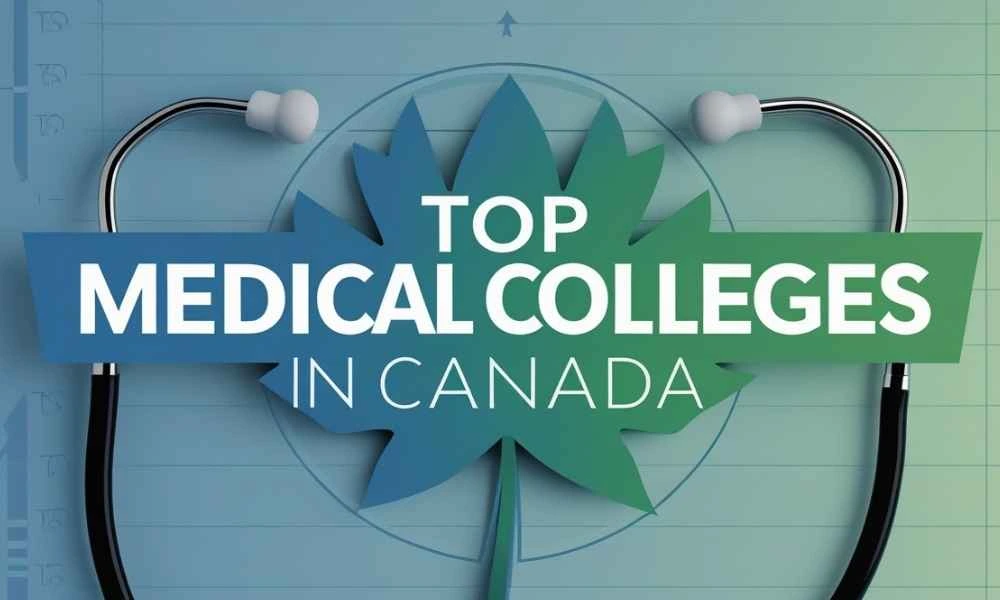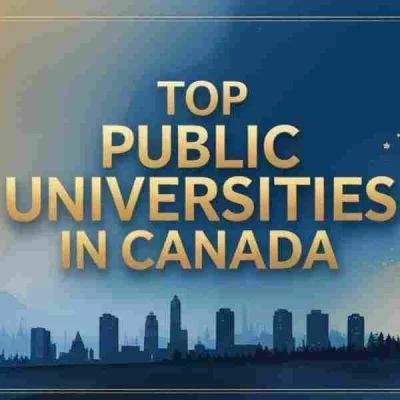Top Medical Colleges in Canada for International Students in 2025
Table of Contents
Dreaming of becoming a doctor in one of the world’s most student-friendly, diverse, and academically advanced countries? You’re not alone! Every year, thousands of international students set their sights on Canada—a country known for its world-class education, cutting-edge research, and inclusive campuses.
But with so many excellent options, it’s natural to wonder: Which are the top medical colleges in Canada for international students in 2025? Whether you’re curious about tuition costs, acceptance rates, global rankings, or what student life looks like, this blog has you covered. From the heart of Toronto to the coasts of British Columbia, let’s explore the top medical schools that are opening their doors to future doctors from all over the world.
Top Medical Colleges in Canada
University of Toronto
The University of Toronto’s Temerty Faculty of Medicine, founded in 1843, is one of the most prestigious and historic medical schools in not just Canada, but the world. It’s located in Toronto, Canada’s largest city, and has been at the forefront of medical discoveries for over 180 years. This is the place where insulin was discovered, and stem cell research also began. Today, it continues to push the boundaries of medical science with over $1 billion CAD annually invested in research.
Every year, the Temerty Faculty attracts more than 1,000 international applicants from over 80 countries, making it one of the most globally diverse campuses. With over 10,000 faculty members, 700+ MD students, and access to more than 50 affiliated hospitals, students are immersed in real-world healthcare from day one. Below are the key details of University of Toronto’s Temerty Faculty of Medicine:
| Statistic | Value |
| Acceptance Rate | Approximately 8.3% |
| Average GPA (Admitted Students) | Around 3.95 |
| MCAT Requirements | Minimum score of 125 in each section (124 accepted in one) |
| Tuition Fees (International Students) | Roughly CAD 91,760 per year |
| Annual Research Budget | Over CAD 1 billion |
| Number of Clinical Sites | More than 50 hospitals and institutions |
| Number of MD Students Enrolled | Over 700 |
| Student-Faculty Ratio | About 6:1 |
| Ranking (Global) | Top 15 worldwide for medicine |
McGill University
McGill University is one of Canada’s most iconic and internationally celebrated institutions. Founded in 1821 and located in Montréal, Québec, McGill’s Faculty of Medicine and Health Sciences has been shaping future doctors and healthcare leaders for over two centuries. Every year, McGill receives over 3,000 applications for its MD program, with a significant number coming from international students.
In fact, about 30% of McGill’s entire student body comes from outside Canada, making it one of the most culturally diverse universities in North America. The university has been consistently ranked in the top 50 medical schools globally, and in 2024, it was ranked #2 in Canada for medicine. The university has been consistently ranked in the top 50 medical schools globally, and in 2024, it was ranked #2 in Canada for medicine. Below are the key details of McGill’s Faculty of Medicine and Health Sciences:
| Statistic | Value |
| Acceptance Rate | Approximately 5.7% |
| Average GPA (Admitted Students) | Around 3.87 |
| Tuition Fees (International Students) | Between CAD 49,274 and 65,881 per year |
| Founded | 1821 |
| Annual Research Funding | Over CAD 700 million |
| MD Program Duration | 4 years |
| Student Diversity | Around 30% international students |
| Language of Instruction | English (with opportunities to engage in French-speaking settings) |
| Global Ranking (Medicine) | Top 50 worldwide |
McMaster University
Located in Hamilton, Ontario, McMaster University’s Michael G. DeGroote School of Medicine has become a trendsetter in the world of medical education. Established in 1966, it may be younger than some of Canada’s other medical schools, but one of its standout features is problem-based learning (PBL) model, a now widely adopted teaching method that actually started here.
McMaster’s MD program is just three years long, one of the shortest in Canada, but it’s intense, highly focused, and fully accredited. It also runs year-round with no summer breaks, which means you’ll get to the next stage of your career faster. Below are the key details of McMaster University’s Michael G. DeGroote School of Medicine:
| Statistic | Value |
| Acceptance Rate | Approximately 3.5% |
| Average GPA (Admitted Students) | About 3.9 |
| MCAT Requirements | Focused on CARS section only – average score 129.2 |
| Program Length | 3 years (no summer breaks) |
| Founded | 1966 |
| Learning Style | Problem-Based Learning (PBL) |
| Ranking (Medicine) | Top 100 globally |
| Language of Instruction | English |
| Location | Hamilton, Ontario |
University of British Columbia
Located in Vancouver, University of British Columbia Faculty of Medicine is a leader in medical education and innovation. Established in 1950, UBC has grown into one of Canada’s largest medical schools, and it’s widely recognized for its distributed medical education model.
This means students don’t just study at one central campus—they receive training across multiple clinical sites throughout British Columbia, including Vancouver, Kelowna, Victoria, and Prince George. It consistently ranks among the top 40 medical schools in the world, and it’s highly respected for its work in Indigenous health, primary care, and global health partnerships. Below are the key details of UBC’s Faculty of Medicine:
| Statistic | Value |
| Acceptance Rate | Approximately 10.9% |
| Average GPA (Admitted Students) | About 88.82% |
| MCAT Requirements | Average score of 514.2 |
| Founded | 1950 |
| Program Duration | 4 years |
| Clinical Training Locations | Over 80 sites across British Columbia |
| Ranking (Medicine) | Top 40 globally |
| Language of Instruction | English |
| Campus Location | Vancouver, BC and regional campuses |
University of Alberta
Located in Edmonton, the University of Alberta’s Faculty of Medicine & Dentistry is one of Canada’s oldest and most respected medical schools. Founded in 1913, the university is known for having one of the highest research incomes per capita among Canadian universities, and medical students benefit from direct access to world-class laboratories and clinical training centers.
One of Alberta’s standout features is its integration of early clinical experience and strong ties with major hospitals like the University of Alberta Hospital, Royal Alexandra Hospital, and Stollery Children’s Hospital. These partnerships give students real-life learning that’s both challenging and inspiring. Below are the key details of University of Alberta’s Faculty of Medicine & Dentistry:
| Statistic | Value |
| Acceptance Rate | Approximately 10% |
| Average GPA (Admitted Students) | Around 3.81 |
| MCAT Requirements | Average score of 511 |
| Founded | 1913 |
| Program Duration | 4 years |
| Primary Teaching Hospitals | University of Alberta Hospital, Royal Alexandra, Stollery |
| Ranking (Medicine) | Top 5 in Canada, Top 100 globally |
| Language of Instruction | English |
| Location | Edmonton, Alberta |
University of Calgary
Founded in 1967, the University of Calgary’s Cumming School of Medicine offers a unique and fast-paced approach to medical education. This school has made a name for itself with its accelerated three-year MD program, one of the few in Canada. Located in Calgary, Alberta, the university is also a research powerhouse, receiving more than CAD 140 million in annual medical research funding and leading the country in brain and mental health research. Following are the key details of University of Calgary’s Cumming School of Medicine:
| Statistic | Value |
| Acceptance Rate | Approximately 9.12% |
| Average GPA (Admitted Students) | Around 3.89 |
| MCAT Requirements | Average score of 513.96 |
| Founded | 1967 |
| Program Length | 3 years (accelerated, no summer breaks) |
| Location | Calgary, Alberta |
| Major Research Strengths | Neuroscience, chronic diseases, public health |
| Primary Teaching Hospitals | Foothills Medical Centre, Alberta Children’s Hospital |
| Language of Instruction | English |
Conclusion
Choosing the right medical school is a big decision—but it doesn’t have to be overwhelming. Canada is home to some of the best medical programs on the planet, with inclusive environments, incredible faculty, and amazing research opportunities for international students. Whether you’re drawn to the fast-paced programs at Calgary and McMaster or the global prestige of Toronto and McGill, there’s a perfect fit waiting for you.
Take your time, do your research, and think about what matters most to you—location, teaching style, costs, or specialization. No matter where you land, studying medicine in Canada is a powerful step toward a meaningful and impactful career. Good luck, future doctors—you’ve got this!
Frequently Asked Questions
What are the top-ranked medical universities in Canada for international students?
The most popular and highly ranked medical schools in Canada for international students include the University of Toronto, McGill University, University of British Columbia, McMaster University, University of Alberta, and University of Calgary. These schools are known for their global reputation, cutting-edge research, and diverse student communities.
Which Canadian medical schools are easiest to get into for international students?
There is no “easy” medical school in Canada—admissions are competitive across the board. However, based on acceptance rates, schools like the University of British Columbia (10.9%) and University of Alberta (10%) have relatively higher acceptance rates compared to McMaster (3.5%) and McGill (5.7%).
Do I need to write the MCAT to apply to Canadian medical colleges?
Most Canadian medical schools require the MCAT (Medical College Admission Test), though the weightage and sections considered vary. For example, McMaster only considers the CARS section, while McGill may waive the MCAT for certain international pathways.
What is the cost of studying medicine in Canada for international students?
Tuition fees vary by institution, but international students can expect to pay between CAD 45,000 to CAD 95,000 per year. For example, the University of Toronto charges around CAD 91,760/year, while McGill ranges from CAD 49,000 to 65,000/year.
Can international medical students stay in Canada after graduation?
Yes! Many students apply for a Post-Graduation Work Permit (PGWP), and later pursue permanent residency through programs like the Canadian Experience Class under Express Entry. Completing medical school in Canada can significantly boost your immigration prospects.
Which Canadian city is best for international medical students?
It depends on your preferences!
- Toronto offers cultural diversity and big-city energy.
- Vancouver is known for its beautiful landscape and lifestyle.
- Montreal gives a European vibe with bilingual flair.
- Calgary and Edmonton provide affordability and strong clinical placements.
Each city offers a unique mix of academics, lifestyle, and student support.







